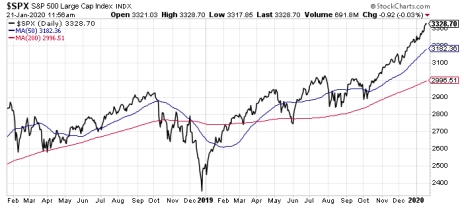Don’t look now but after 14 long months of doing nothing small-cap stocks are finally moving higher again.
Does this mean small caps are worthy of your attention in 2020? The short answer is yes. Here are three reasons why.
Bullish Reason #1: The Small-Cap Index Chart Looks Terrific
If you follow stock charts at all you should love the look of the small-cap index right now. After retreating below the 1,000 level in October 2018, then trading mostly in the 900 to 1,000 level for 14 months, the S&P 600 Small Cap Index finally staged a convincing breakout to a 12-month high in early-December 2019. It has continued to climb higher since and is now trading 6% off all-time highs.
[text_ad]
This chart looks good when viewed on its own. But it looks even more compelling when viewed next to the chart of the S&P 500 Index, which has been making all-time highs for many months now.
If business is so good for large caps and has powered these stocks so much higher, one would think that some of the same forces would be good for small caps. At some point investors will begin to look down the market cap curve for less crowded trades and will land on small caps. That might be happening now, and the small-cap index is starting to respond by moving higher.
Bullish Reason #2: Small Caps Should Benefit from High U.S. Exposure
Remember that investing in small caps is like a leveraged play on the U.S. economy since roughly 80% of small-cap sales come from within the U.S. (compared to about 70% of S&P 500 revenues). Therefore, if you’re bullish on the U.S. economy you should be, by extension, bullish on small-cap stocks.
Furthermore, historical data suggests small caps do well when U.S. GDP is in the 2% to 3% range. The latest estimates suggest GDP should within that range in 2020.
Bullish Reason #3: Small Caps Trade At Discounted Valuation To Large Caps
Right now, the S&P 600 Small Cap Index trades with a forward P/E ratio of 17.8. That’s not a particularly cheap valuation, but it’s well below the levels above 20 from late-2016 through early-2018. It’s also below the 18 level that persisted many times over the last seven years. Furthermore, that valuation represents a discount to large-cap stocks, which trade with a forward P/E of 18.7.
Assuming this is a bull market (I think it is) that’s compelling evidence that either small caps should trade higher, or that large caps should pull back, or at least level off and give small caps a chance to catch up.
Beyond just valuation, there’s also a relative earnings growth story argument to consider.
Specifically, the latest analyst estimates show small caps are expected to grow earnings by 15.5% in 2020 and 13.9% in 2021. In comparison, large caps are expected to grow earnings at a slower rate in both years; by 9.6% in 2020 and by 10.7% in 2021.
In other words, small-cap stocks are trading at a discounted valuation as compared to large-cap stocks but are expected to grow earnings faster over the next two years!
This is important because forward earnings tend to be a great leading indicator of actual earnings (provided there is no recession) and both forward earnings and actual earnings factor heavily into stock price performance.
As a final note, both expected earnings growth rates are good, and an improvement over 2019, when large caps barely grew earnings at all due to the very hard comparison with 2018 when tax-cut-inspired earnings drove the growth rate to an absurdly high 23.8%
The Best Way To Invest In Small-Cap Stocks in 2020
If you want to get exposure to the small-cap stock asset class by far the easiest way to go is to just buy an ETF that tracks the S&P 600 Index. The iShares Core S&P 600 Small Cap ETF (IJR) is a great way to go if this is the type of exposure you want.
That said, I’m not a huge fan of ETFs because I’m mostly interested in the long-term potential of great small-cap companies and buying an ETF removes much of that potential. That’s because as small caps grow into mid-caps they migrate out of the underlying index, and therefore out of your portfolio. The only way to stay in those stocks is to buy the individual stocks or find a mutual fund that will hold them even if they grow out of the small-cap asset class.
These long-term growers are the companies I’m looking to add to both Cabot Small-Cap Confidential, which includes mostly technology and healthcare stocks, and Cabot Early Opportunities, which includes stocks from all sectors and includes IPOs too.
The stocks in both of my advisories are doing extremely well right now and with many more small-cap stocks starting to come to life my watch list of future ideas is growing by the day.
If you’re interested in joining our small group of subscribers, I’d love to have you. Get started here.
[author_ad]




